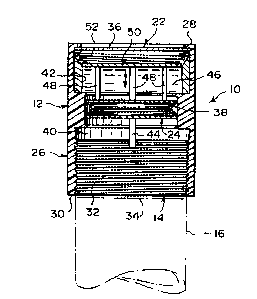Une partie des informations de ce site Web a été fournie par des sources externes. Le gouvernement du Canada n'assume aucune responsabilité concernant la précision, l'actualité ou la fiabilité des informations fournies par les sources externes. Les utilisateurs qui désirent employer cette information devraient consulter directement la source des informations. Le contenu fourni par les sources externes n'est pas assujetti aux exigences sur les langues officielles, la protection des renseignements personnels et l'accessibilité.
L'apparition de différences dans le texte et l'image des Revendications et de l'Abrégé dépend du moment auquel le document est publié. Les textes des Revendications et de l'Abrégé sont affichés :
| (12) Brevet: | (11) CA 2269787 |
|---|---|
| (54) Titre français: | BOUCHON CONTROLEUR DE PRESSION D'UN PNEU A LECTURE DIRECTE |
| (54) Titre anglais: | VISUAL TIRE CAP PRESSURE GAUGE |
| Statut: | Périmé et au-delà du délai pour l’annulation |
| (51) Classification internationale des brevets (CIB): |
|
|---|---|
| (72) Inventeurs : |
|
| (73) Titulaires : |
|
| (71) Demandeurs : |
|
| (74) Agent: | OSLER, HOSKIN & HARCOURT LLP |
| (74) Co-agent: | |
| (45) Délivré: | 2002-07-16 |
| (86) Date de dépôt PCT: | 1996-10-28 |
| (87) Mise à la disponibilité du public: | 1998-05-07 |
| Requête d'examen: | 1999-04-23 |
| Licence disponible: | S.O. |
| Cédé au domaine public: | S.O. |
| (25) Langue des documents déposés: | Anglais |
| Traité de coopération en matière de brevets (PCT): | Oui |
|---|---|
| (86) Numéro de la demande PCT: | PCT/US1996/017266 |
| (87) Numéro de publication internationale PCT: | WO 1998018639 |
| (85) Entrée nationale: | 1999-04-23 |
| (30) Données de priorité de la demande: | S.O. |
|---|
Un bouchon contrôleur de pression d'un pneu à lecture directe (10) comprend un capuchon (12). Une structure à l'intérieur du capuchon (12) sert à fixer le capuchon sur une tige de soupape (16) d'un pneu (18) de véhicule à moteur (20). Une lentille (22) est monté sur une extrémité supérieure du capuchon (12). Un système (24) à l'intérieur du bouchon affiche directement le niveau de pression d'air dans le pneu (18) lorsque ce niveau descend au-dessous d'un point donné, ce qui permet à une personne d'apprécier d'un coup d'oeil si le pneu nécessite plus d'air.
A visual tire cap pressure gauge (10) which comprises a cap member (12). A
structure within the cap member (12) is for securing the cap member to a valve
stem (16) on a tire (18) in a motor vehicle (20). A lens (22) is mounted in a
top end of the cap member (12). An assembly (24) within the cap is for
visually indicating when air pressure within the tire (18) drops below a set
point, so as to enable a person at a glance to tell if the tire needs more air.
Note : Les revendications sont présentées dans la langue officielle dans laquelle elles ont été soumises.
Note : Les descriptions sont présentées dans la langue officielle dans laquelle elles ont été soumises.

2024-08-01 : Dans le cadre de la transition vers les Brevets de nouvelle génération (BNG), la base de données sur les brevets canadiens (BDBC) contient désormais un Historique d'événement plus détaillé, qui reproduit le Journal des événements de notre nouvelle solution interne.
Veuillez noter que les événements débutant par « Inactive : » se réfèrent à des événements qui ne sont plus utilisés dans notre nouvelle solution interne.
Pour une meilleure compréhension de l'état de la demande ou brevet qui figure sur cette page, la rubrique Mise en garde , et les descriptions de Brevet , Historique d'événement , Taxes périodiques et Historique des paiements devraient être consultées.
| Description | Date |
|---|---|
| Inactive : Regroupement d'agents | 2013-10-24 |
| Le délai pour l'annulation est expiré | 2003-10-28 |
| Lettre envoyée | 2002-10-28 |
| Accordé par délivrance | 2002-07-16 |
| Inactive : Page couverture publiée | 2002-07-15 |
| Inactive : Taxe finale reçue | 2002-05-02 |
| Préoctroi | 2002-05-02 |
| Un avis d'acceptation est envoyé | 2001-11-13 |
| Un avis d'acceptation est envoyé | 2001-11-13 |
| Lettre envoyée | 2001-11-13 |
| Inactive : Approuvée aux fins d'acceptation (AFA) | 2001-10-30 |
| Inactive : Page couverture publiée | 1999-07-22 |
| Inactive : CIB en 1re position | 1999-06-10 |
| Inactive : Acc. récept. de l'entrée phase nat. - RE | 1999-05-27 |
| Demande reçue - PCT | 1999-05-25 |
| Toutes les exigences pour l'examen - jugée conforme | 1999-04-23 |
| Exigences pour une requête d'examen - jugée conforme | 1999-04-23 |
| Demande publiée (accessible au public) | 1998-05-07 |
Il n'y a pas d'historique d'abandonnement
Le dernier paiement a été reçu le 2001-10-22
Avis : Si le paiement en totalité n'a pas été reçu au plus tard à la date indiquée, une taxe supplémentaire peut être imposée, soit une des taxes suivantes :
Veuillez vous référer à la page web des taxes sur les brevets de l'OPIC pour voir tous les montants actuels des taxes.
| Type de taxes | Anniversaire | Échéance | Date payée |
|---|---|---|---|
| Taxe nationale de base - petite | 1999-04-23 | ||
| TM (demande, 2e anniv.) - petite | 02 | 1998-10-28 | 1999-04-23 |
| Requête d'examen - petite | 1999-04-23 | ||
| TM (demande, 3e anniv.) - petite | 03 | 1999-10-28 | 1999-09-15 |
| TM (demande, 4e anniv.) - petite | 04 | 2000-10-30 | 2000-10-20 |
| TM (demande, 5e anniv.) - petite | 05 | 2001-10-29 | 2001-10-22 |
| Taxe finale - petite | 2002-05-02 |
Les titulaires actuels et antérieures au dossier sont affichés en ordre alphabétique.
| Titulaires actuels au dossier |
|---|
| CRAIG CUMMINGS |
| Titulaires antérieures au dossier |
|---|
| S.O. |